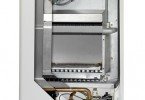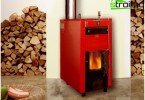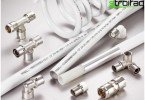Copper fittings and pipes for heating
The key to a long service life of the heating system is the high quality of the connecting components and pipes. Most often, copper is used in communications for heating. No other material with copper can be compared in the versatility of its application. Copper pipes meet all the requirements of modern consumers. Couplings and fittings for copper pipes do not age and retain their strength.
Content
- The emergence of copper pipes and fittings
- The use of copper in engineering networks
- The effect of copper on the human body
- Copper pipe parameters
The emergence of copper pipes and fittings
The active use of pipes and connectors made of copper in the installation of heating systems in Europe has introduced a fashion for these products in our country. Every day, an increasing number of domestic consumers give preference in their favor. This popularity is also due to the fact that copper is a resistant material to the most commonly used water disinfectant, chlorine..
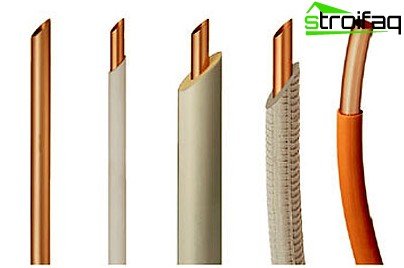
Copper pipelines for heating in domestic conditions
Pipes and copper press fittings are ideal for installation in standalone communication systems, but direct contact of copper with aluminum should be avoided.
Pipes and fittings in a properly designed heating system, with the correct connection and use, will last for decades without any trouble.
The use of copper in engineering networks
Copper plays a huge role in the modern world, the need for its properties will remain relevant in the future. The main distinguishing feature of copper is its long service life. Pipes and fittings are used for all types of utilities, including for heating and hot water systems.
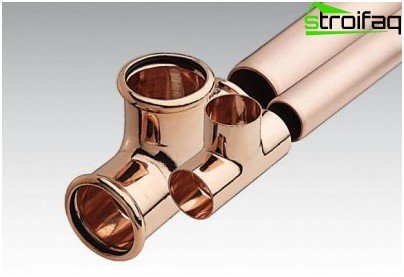
Copper pipes improve the transported water, protect users from harmful bacteria
Pipes and copper fittings are considered optimal working materials, because they are equally suitable for equipping old and new buildings, they are easy to process in any construction sites – when bending around holes, corners and other possible obstacles.
Phosphorus deoxidized copper is used for home heating communications. It is flexible and soft, therefore, it can withstand dynamic loads and is practically not subject to corrosion. This material is resistant to ultraviolet radiation, but plastic under the influence of UV radiation can “evaporate”.
The melting temperature of copper from which pipes and fittings are made is more than one thousand degrees, so when cooling and heating fittings for copper pipes do not change their linear dimensions, which can not be said, for example, about a steel pipe. The maximum allowable water temperature is 250 degrees Celsius. Due to the elasticity of copper, the pipes, when solidifying the energy carrier in them, are deformed without breaks.
The effect of copper on the human body
To the above advantages, it is worth adding that this metal is not at all harmful to the human body. When working in the system, copper pipes for heating produce a small amount of copper in the transported water. This element positively affects digestion quality, bone strength, blood hemoglobin level and skin color..
Copper is characterized by a bacteriostatic effect – the ability to kill most of the bacteria. Therefore, it is not surprising that any sane person has a natural desire to quickly replace old pipes with copper products in their home.
Copper pipe parameters
Copper pipes are marked accordingly to identify products by their physicochemical properties. The density of the pipe does not affect the operation of the heating system in the house, but it matters when it is installed. Pipes of lower density are much lighter, therefore they are easier to transport and install, and supports for supporting pipelines can be chosen less powerful.
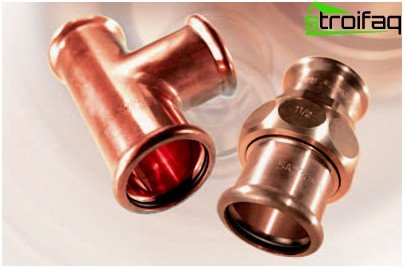
The presence of press fittings for copper pipes allows you to build contours of any configuration and length
The index of the limiting melting temperature determines at what temperature the material melts. The higher this parameter, the higher the temperature the liquid circulating in the heating system made of copper can have.
Thermal expansion of copper allows you to determine how capable of elongation of the product under prolonged exposure to high temperatures. A copper pipe, which has a length of 10 meters, extends under the influence of temperature of 90 degrees Celsius by about 1 centimeter.
The lower the heat transfer coefficient, the less heat will be lost by hot water in uninsulated pipes of the heating system. Pipes and copper fittings for soldering, which are characterized by a low coefficient of thermal conductivity, do not need thermal insulation.
The porosity coefficient describes the smoothness of the inner surface of the copper pipe and connecting elements. The smoother it is, and the porosity coefficient is correspondingly lower, the lower the resistance to fluid flow and the less likely the occurrence of various deposits, and therefore the material is less destroyed.
What copper pipes are on the market?
There are different types of copper pipes. Choose products that have a certificate that allow their use in heating and hot water networks.
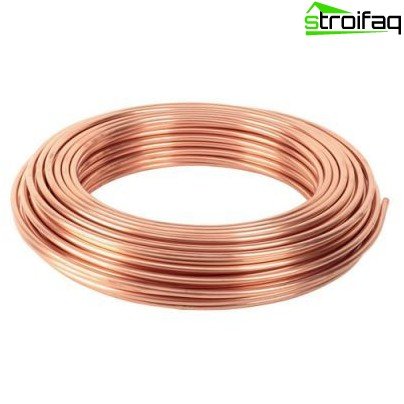
Copper pipe for heating in a coil
In the entire heating system of the house, it is necessary to use the same type of copper. Soft pipes, which have a diameter of up to 22 millimeters, are sold wound into coils, and at construction sites they can be bent into a wide variety of shapes. Other types of pipes with a large diameter are available on the market in straight three- or five-meter sections..
Today, many manufacturing companies offer copper pipes for heating in a plastic casing – to protect against all kinds of mechanical damage or in a casing made of polyurethane foam, which is excellent thermal insulation in unheated buildings.
Installation of copper pipes and fittings
Copper pipes and connecting elements have been used in heating systems for a long time and have proven themselves perfectly. The main technique for connecting such pipes in heating systems is soft soldering.
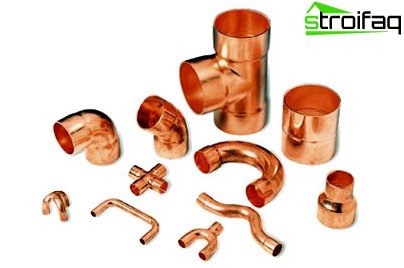
Solder Copper Fittings
Pipe segments are interconnected using solder matched to the type of system. Often, copper crimp fittings are used for connections, the installation of which requires a special tool.
In a heating system, connect copper pipes to aluminum radiators it is impossible, because the contact of these metals in an aggressive environment leads to a chemical reaction, which entails increased gas generation, and subsequently the heating radiator at home can simply break.
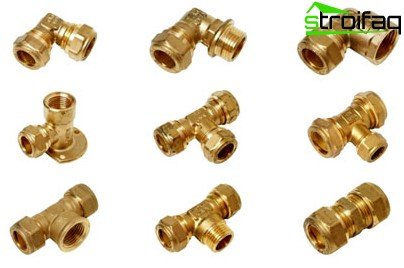
Copper Crimp Fittings
To avoid such undesirable consequences, it is recommended to separate these two materials with steel or plastic fittings, and equip the radiators with gas vent valves. From an aesthetic point of view, such pipes and fittings are also attractive because they acquire a pleasant color over the years, which can add a twist to the interior of the room.
Copper pipes need thermal insulation. For this purpose, you need to stock up with ready-made casings made of polyurethane foam with various internal sections, which can easily be selected to the diameter of the copper pipe.
Thus, copper pipes and fittings are used for all types of utilities in the house, including heating systems. Copper has an unusually long life, which is why it is so popular. Copper pipes and fittings can last as long as the building itself exists..


